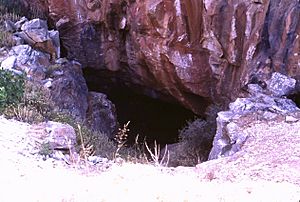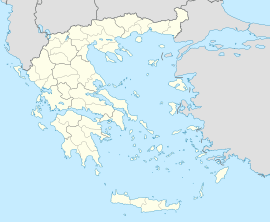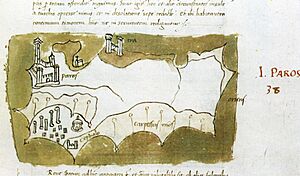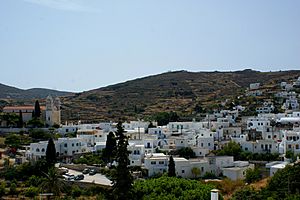Paros facts for kids
Quick facts for kids
Paros
Πάρος
|
|
|---|---|

From top left: Parikia, Panagia Ekatontapiliani, the Frankish Castle and a typical Paros street
|
|
| Country | Greece |
| Administrative region | South Aegean |
| Regional unit | Paros |
| Area | |
| • Municipality | 196.3 km2 (75.8 sq mi) |
| Highest elevation | 724 m (2,375 ft) |
| Lowest elevation | 0 m (0 ft) |
| Population
(2021)
|
|
| • Municipality | 14,520 |
| • Municipality density | 73.97/km2 (191.58/sq mi) |
| Demonym(s) | Parian |
| Community | |
| • Population | 6,204 (2021) |
| Time zone | UTC+2 (EET) |
| • Summer (DST) | UTC+3 (EEST) |
| Postal code |
844 00
|
| Area code(s) | 22840 |
| Vehicle registration | EM |
Paros (/ˈpɛərɒs/; Greek: Πάρος) is a beautiful Greek island in the middle of the Aegean Sea. It is part of the Cyclades group of islands. Paros is located west of Naxos, with a channel about 8 kilometers (5 miles) wide separating them. It's about 150 kilometers (93 miles) southeast of Piraeus, which is a major port city in Greece.
The area around Paros also includes many small, uninhabited islands. The total land area of the municipality of Paros is about 196 square kilometers (76 square miles). Its closest neighbor is the island of Antiparos, which is to its southwest. Long ago, in ancient Greece, the city-state of Paros was found on this island.
Historically, Paros was famous for its amazing white marble. This marble was so special that the word Parian was used to describe marble or porcelain that had similar high quality. Today, you can still find old marble quarries and mines on the island. Some of them are even still used! But now, Paros is mostly known as a very popular place for tourists to visit.
Contents
Geography of Paros
Paros is located at 37° N latitude and 25° 10' E longitude. The island covers an area of about 165 square kilometers (64 square miles). Its longest part, from northeast to southwest, is 21 kilometers (13 miles). The widest part is 16 kilometers (10 miles).
The island looks like a round, plump pear. It has one main mountain, which is 724 meters (2,375 feet) high. This mountain slopes gently down on all sides to a flat area near the sea. The island is mostly made of marble. However, you can also find other rocks like gneiss and mica-schist in a few spots.
To the west of Paros is its smaller sister island, Antiparos. The water channel between the two islands is less than 2 kilometers (1.2 miles) wide at its narrowest point. A ferry that carries cars runs all day between Pounda (on Paros) and Antiparos. Pounda is about 5 kilometers (3 miles) south of Parikia. There are also about a dozen smaller islands surrounding Paros.
Paros has many beautiful beaches. Some popular ones include Golden Beach (Chrissí Aktí) near Drios on the east coast. Other great beaches are at Pounda, Logaras, Piso Livadi, Naousa Bay, Parikia, and Agia Irini. The strong, steady wind in the strait between Paros and Naxos makes it a favorite spot for windsurfing.
Islands near Paros
- Gaiduronisi – north of Xifara
- Portes Island – west of the town of Paros
- Tigani Island – southwest of Paros
- Drionisi – southeast of Paros
History of Paros
Ancient Times
Paros was settled by people from Athens long ago. They were called Ionians, and under their rule, the island became very successful. Paros even started its own settlements on other islands, like Thasos and Parium. The famous poet Archilochus, who was from Paros, is believed to have been part of the group that settled Thasos. Later, around 385 BC, people from Paros also helped start a settlement on the island of Pharos (Hvar).
Before the Greco-Persian Wars, Paros was connected to Naxos. During the first Greco-Persian War (490 BC), Paros chose to support the Persians. They even sent a warship to Marathon to help them. Because of this, an Athenian fleet led by Miltiades attacked the capital city of Paros. The Athenians demanded a large payment, but the town fought back strongly. After 26 days, the Athenians had to leave. Miltiades was hurt at a temple of Demeter in Paros, and he later died from this injury.
Paros also sided with the Persian king Xerxes I during the second Greco-Persian War (480–479 BC). However, after a big sea battle, the Parian ships stayed quiet and didn't join the fight. Because they had supported the Persians, the Athenian leader Themistocles later made the islanders pay a heavy fine.
Paros then joined the Delian League, which was a group of Greek city-states led by Athens. Paros paid the most money to this league out of all the island members. This shows that Paros was one of the richest islands in the Aegean Sea. Later, Paros became part of the Roman Empire. After that, it was part of the Byzantine Empire, which was the Greek-speaking continuation of the Roman Empire.
Crusades and Ottoman Rule
In 1204, soldiers from the Fourth Crusade took over Constantinople, the capital of the Byzantine Empire. Many Byzantine lands, including Paros, were then taken over by these crusading powers. Paros became part of the Duchy of the Archipelago. This was a group of Aegean islands ruled by a Venetian duke. The duchy was closely connected to the Republic of Venice.
In 1537, the Ottoman Turks conquered Paros. The island remained under Ottoman rule until the Greek War of Independence (1821–1829). During a war between Russia and Turkey (1768–1774), Naoussa Bay on Paros was used as a base for the Russian navy.
Under the Treaty of Constantinople (1832), Paros became part of the new, independent Kingdom of Greece. This was the first time in over 600 years that people from Paros were ruled by other Greeks. During this time, Paros became home to Manto Mavrogenous, a brave woman who was a hero of the Greek fight for freedom. She helped pay for the war and even fought in it. Her house, near the Ekatontapiliani church, is now a historical site.
World War II and German Occupation
During World War II, Paros was first occupied by Italian forces until 1943. Then, in 1944, the Nazis took control of the island. They ruled very harshly.
Because Paros was important for military reasons, the Germans forced over 400 Greek workers to build an airfield near the village of Marpissa. Local people resisted this. They were helped by the Allies (like Britain and the US). Nikolas Stellas, a 23-year-old fighter, became a key leader in this resistance. The Germans captured Stellas, but he refused to give them any information. He was publicly executed, becoming a symbol of bravery. In response, 125 people from Paros were sentenced to death. However, a German commander, Major Georg Graf von Merenberg, was convinced by a local abbot to spare them. He was moved by Stellas' sacrifice and the abbot's plea.
British commandos and local fighters worked together to attack the German forces on Paros. They cut German communication lines and captured an important German officer. These efforts helped disrupt German military plans in the Aegean Sea during World War II. The airfield built by the Germans in Marpissa was later bombed by the British. Today, there are no remains of this airfield.
Paros in the 21st Century
On September 26, 2000, a ferry called MS Express Samina hit the Portes islets near Parikia bay. Sadly, 82 people on board died.
In the summer of 2023, people living on Paros started protesting on many beaches. They were upset because businesses were putting out more umbrellas than allowed by the government. The protests worked! The Greek government started checking more strictly and giving fines to businesses that broke the rules.
Parikia
The capital city of Paros is Parikia (Greek: παροικία). It is located on a bay on the northwest side of the island. Parikia is built on the same spot as the ancient capital of Paros. The harbor in Parikia is a very busy place for ferries and catamarans that travel between the Aegean islands. Many boats sail daily to Piraeus (the port of Athens), Heraklion (the capital of Crete), and other islands like Naxos, Ios, Mykonos, and Santorini.
In Parikia town, the houses are built in the traditional Cycladic style. This means they have flat roofs, whitewashed walls, and blue-painted doors and window frames. Many houses are shaded by beautiful vines and surrounded by gardens with orange and pomegranate trees. This makes the town look very charming.
Above the main road along the seafront, you can see the remains of a medieval castle. This castle was built almost entirely from marble pieces taken from an ancient temple dedicated to Apollo. You can find other signs of ancient times around town, like bas-reliefs (carvings), old writings, and parts of columns. On a hillside south of Parikia, there are also the remains of a temple dedicated to Asclepius. Near the modern harbor, you can see parts of an ancient cemetery that were found recently.
About 400 meters (1,300 feet) left of Parikia's main square is the town's most important church, the Panagia Ekatontapiliani. Its name means "church of the hundred doors." The oldest parts of this church were built even before Christianity became the official religion of the Roman Empire in 391 AD. People say that Saint Helen, the mother of the Roman Emperor Constantine the Great, founded the church during her trip to the Holy Land. The church has two smaller chapels next to it and a baptistery with a cross-shaped font for baptisms.
The Archaeological Museum of Paros is located in Parikia. It's a small but interesting museum that holds many items found at sites on Paros. However, the most important pieces are kept in the Athens National Archaeological Museum. The Paros museum has a piece of the Parian Chronicle. This is a very special marble tablet with a timeline of ancient Greece. It lists important events from 1500 BC all the way to 264 BC.
Other Settlements on Paros
On the north side of the island is the bay of Naoussa. This bay offers a large, natural harbor for boats. Long ago, it could be closed off with a chain. Today, Naoussa is growing a lot as a tourist destination.
Another popular harbor is Drios, on the southeast side of the island. During the time of Ottoman rule (1537–1832), the Turkish navy used to anchor here every year when they sailed through the Aegean Sea.
The three villages of Prodromos, Marmara, and Marpissa are located on a flat plain on the eastern side of the island. These villages have many ancient ruins. They are probably built on the site of an old town. People sometimes call them the "villages of Kephalos" because of the tall, steep hill of Kephalos nearby. On top of this hill is the monastery of Agios Antonios (St. Anthony). Around the monastery are the ruins of a medieval castle. This castle belonged to a Venetian noble family who fought a battle against the Turkish admiral Barbarossa in 1537.
Another village on Paros is Lefkes (Λεύκες). Lefkes is a mountain village located inland, about 10 kilometers (6 miles) from Parikia. In the late 1800s, Lefkes was an important center for the area. Many people moved to Athens in the 1970s as cities grew. However, in recent years, tourism has brought new income to Lefkes. This has led to homes being rebuilt and the village being made more beautiful for visitors. In the 2011 census, Lefkes had 545 people living there.
Marble Quarries

Parian marble was the main source of wealth for the island. This marble is white and translucent, meaning light can pass through it. It has a rough texture but is very beautiful. The famous marble quarries are on the northern side of the mountain, which was known as Marathi in ancient times. They are located a little below an old monastery called St Mina.
This marble was sent out from Paros starting in the 6th century BC. Famous ancient Greek sculptors like Praxiteles used it for their artworks. The marble was taken out of the ground through underground tunnels that went horizontally or angled down into the rock. Because the marble was mined by lamplight, it was called Lychnites, Lychneus (from lychnos, meaning a lamp), or Lygdos. You can still see several of these tunnels today. At the entrance to one tunnel, there is a carving dedicated to Pan and the nymphs.
People have tried to mine the marble again in modern times, but not much has been exported. Most of the remaining white marble is now owned by the government. Like the marble from Penteliko Mountain, it is only used for restoring ancient buildings and statues.
Notable People from Paros
- Ancient Times
- Agoracritus (5th century BC), a sculptor
- Archilochus (c. 680 BC–c. 645 BC), a poet
- Satyros (4th century BCE), an architect and sculptor
- Scopas (c. 395–350 BC), a sculptor and architect
- Theoctiste of Lesbos (9th century), a hermit saint
- Thrasymedes (4th century BC), a sculptor
- Thymaridas (c. 400 BC–350 BC), a mathematician
- Modern Times
- Nurbanu Sultan (Cecilia Venier-Baffo) (1525–1583), mother of Ottoman Sultan Murad III
- Vassilis Argyropoulos (1894–1953), an actor
- Nicholas Mavrogenes (1738–1790), a prince
- Athanasius Parios (1721/22–1813), a religious scholar
- Manto Mavrogenous (1796–1848), a heroine in the Greek War of Independence
- Joseph the Hesychast (1897-1959), a monk
- Augoustinos Kantiotes (1907-2010), a bishop
- Yiannis Parios (1946-), a musician
- Yiannis Ragousis (1965–), a politician
- Argyro Barbarigou (1967-), a celebrity chef
- Christos Perakis (1973-2024), an entrepreneur
- Stan (Stratos Antipariotis) (1987-), a musician
- Christos Arianoutsos (1993-), a footballer
Gallery
See also
 In Spanish: Paros para niños
In Spanish: Paros para niños
























